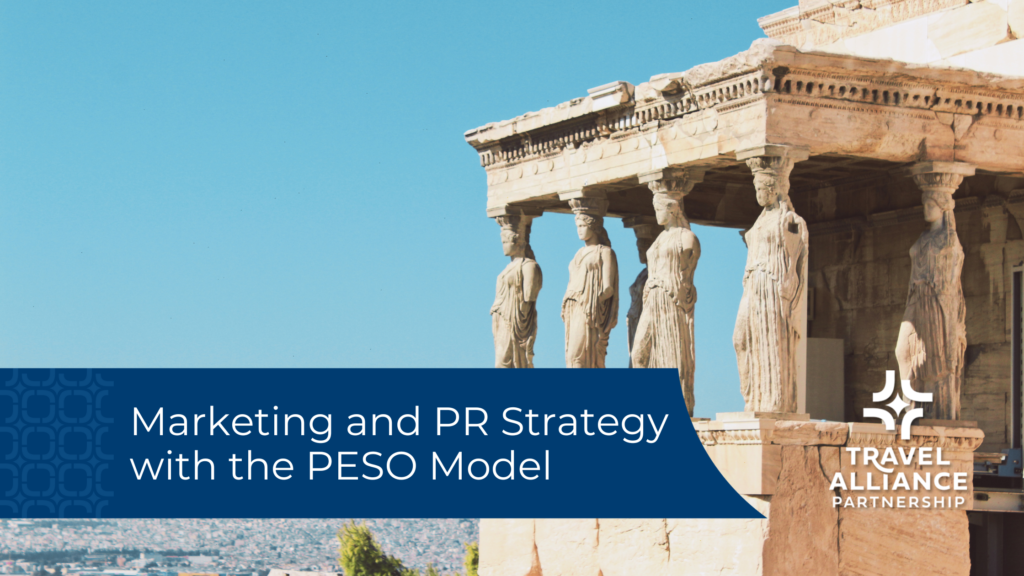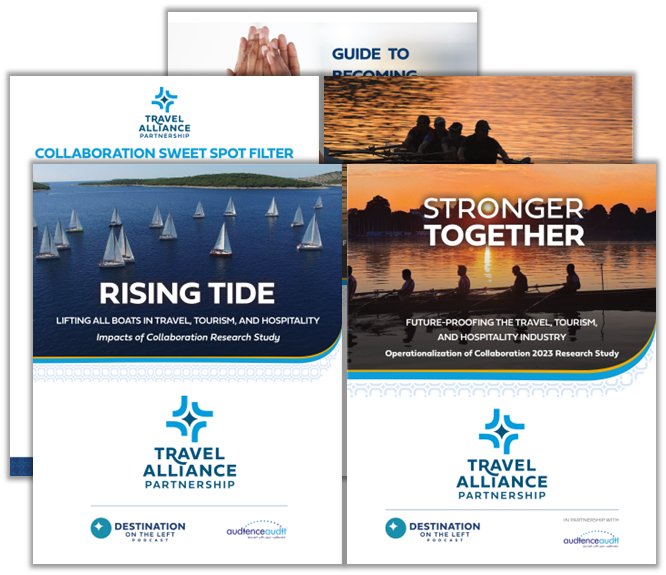Marketing and PR Strategy with the PESO Model
Strategy is always a big topic of conversation when it comes to tourism marketing. We’ve been responding to more and more requests for strategy, and it is always our first solution. Everyone is working with many moving parts, and no matter the size of an organization, we are all tasked with doing more with what you have and stretching your resources to the max. When it feels like just getting promotions out the door is an accomplishment, strategy is the answer. Taking a step (or two) back to return to strategy provides structure and peace of mind that all the bases are covered. While strategy provides the structure, it needs the support of an actionable and realistic tactical plan. Our approach to actionable tactics that feed strategy is the PESO model.

When we build a tourism marketing and/or PR strategy for our clients, we use the PESO model. This is a model for strategy developed by Gini Dietrich, founder, author and CEO of Spin Sucks. She created it to empower PR professionals to be more and do more than the typical idea of public relations. It is also a fantastic approach to building strategy. The ‘PESO’ acronym stands for Paid, Earned, Shared and Owned Media. We use the framework to take our strategy into action, tying all tactics back to the main goals and messages for a holistic campaign.
P is for Paid
Paid media is often the first thing people think of when they want to promote an idea or service. And it definitely has a place in a robust strategic plan. But it doesn’t have to break the bank, and it really needs the support of its three companions.
Paid media needs to drive toward your goals and make the most of your budget. Google (and YouTube) and Meta (aka Facebook and Instagram) are among the most affordable, cost-effective and versatile options in the digital advertising realm. Those channels are often foundational for our paid media plans, followed by other popular or desired channels. Recently, requested and explored channels include streaming video, Pinterest and direct mail.
See how we paired paid media with owned to generate demand for a tour operator.
E is for Earned
Earned media may be mistaken as only representing public relations or media relations. It’s actually about earning third-party endorsements. Very often for destinations, this takes the form of PR as the lowest-hanging fruit. However, when working with tour operators, we turn to review management. Awards are another way of building credibility.
Earned media means the end results are not paid advertisements. With PR, the results are placements with impressions. With reviews, the results are ratings and comments. Awards are the awards themselves, but for certain arenas may also be nominations or runner-up status. This publicity helps promote your organization and tell your story through different voices and angles, including ways you may not be able to talk about yourself.
As specialists in travel PR, it’s worthwhile to note that PR does have a place for almost every organization, even if it’s not the first tactic we recommend for every client.
Our approach to earned media involves both proactive and reactive methods. We build relationships with media by seeking out relevant journalists and influencers with highly-targeted pitches. We measure earned media results using the industry-standard Barcelona Principles.
Read about strategic PR in action with a history and DEI campaign for Auburn, NY.
S is for Shared
Shared platforms – social media – were long debated. Who “owns” and takes responsibility for a brand’s social channels? I love that this model essentially ends the tug-of-war between marketing, sales and PR. Social is its own thing – a channel and a way of reaching people in its own right. Managing social media requires a unique skillset and knowledge of the digital landscape.
Another reason I love that this is called Shared Media and doesn’t fall under owned media, is because these social platforms are separate entities. Your email provider cannot take away your customers’ emails, that’s an owned channel that you control. But a social media platform has the final say in how you reach your customers on their platform. This is a concept covered really well in the book Killing Marketing by Joe Pulizzi and Robert Rose. Shared media is also about community and includes private social channels.
Our approach in this pillar revolves around maintaining a consistent presence across channels by recycling evergreen, key message posts to keep up with the never-ending nature of social media. This allows us the flexibility to curate trendy and timely content while ensuring a steady hum of activity.
See how this approach to social media is working for one of our tour operator clients.
O is for Owned
Owned Media are the places you can share your messages that you have full control over. It’s the channels that you own – your website, blog, email newsletters, even direct mailing lists and phone numbers. It’s wherever you can reach your audience, it’s where you are in control of how and when and what the message is.
Owned media is the most valuable marketing asset because of this full ownership. These tactics are the foundation that carry your strategic messaging to your audience in the clearest way. The basics of owned media is a website that’s up-to-date, information-rich and easy to navigate paired with a growing email list that receives frequent and relevant communications. Then we build from there.
Owned media is also where some of the most fun tactics and ideas live. Apps, contests, surveys, games are the fun, creative projects that add to – and stem from – owned media.
This example of owned media combines growing an email list using a creative contest.
Each of these elements is an important pillar of marketing and PR strategy, but it’s only when they are planned in conjunction that you reap the full benefits of a strong tourism marketing strategy.
Author
Related Posts
How Curated Experiences Can Help Your Tourism Marketing
In years past, travelers may have been satisfied to see sites like the Eiffel Tower or Colosseum; now they want to get behind the scenes,...
Marketing for Group Travel: Building Solid Relationships with Tour Operators
Group travel is a significant segment of the tourism market, and if you want to see those buses pulling up to the curb and filling…
